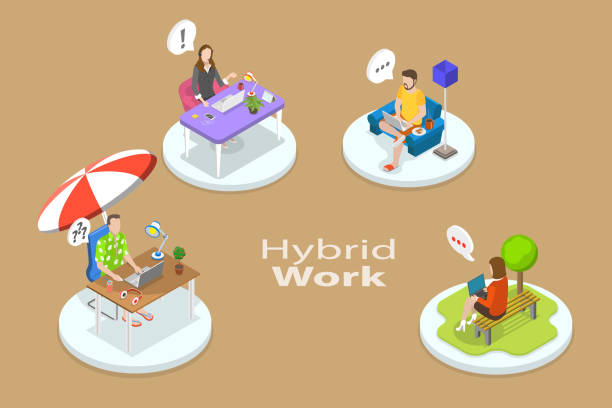Many flexible work models have been around for some time in the workplace, but these initiatives have grown significantly since the onset of the coronavirus pandemic. While the benefits of remote work are well known, it’s not for everyone or every business. Hybrid work culture is an excellent option for employees and teams. Who can work well both in the office and remotely.
According to a recent Harvard Business School survey, most professionals today want a hybrid work model that allows them to come into the office two or three days a week rather than working exclusively remotely or entirely in the office. By offering this flexibility, companies can improve the employee experience, attract more talent and maintain or increase productivity. As hybrid workspace models become more common, managers must do everything they can to support their team members and ensure a quality employee experience.
Managing a hybrid environment can be a challenge during the first transition. To help managers make hybrid work environments a success for their employees, the Monitoring Software team has compiled a list of tips and best practices.
What Is A Hybrid Work Environment?
A hybrid work environment includes the physical and digital resources needed to support a combined office and remote work model. In some cases, all employees share the office and remote work. Within a single company, there may also be three types of employees working in a hybrid work environment: those who work full-time on-site, those who work full-time remotely, and those who work both on-site and remotely. In a mixed work environment, a company can use any type of work model – entirely on-site, fully remote, or a combination of both – to find an approach that allows employees to work more efficiently.
Tips for Supporting Hybrid Teams
Employees who work in an office or remotely or split their time have different needs. As a manager, it’s your responsibility to ensure that all employees receive the support they need and to create a thriving hybrid environment in which everyone feels part of the team and is valued, regardless of where they work. In addition to these tips for effective hybrid team management, you should consider the following information for a successful hybrid workplace.
1. Create A Level Playing Field For All Workers.
In a hybrid environment, there are often hierarchies, conscious or not, about when and where people work. As a manager, it’s important to emphasize that hybrid work is a supported work model and not just something that is allowed.
When evaluating employee performance, you need to be aware of “proximity bias” (the idea that employees who are physically closer to the office perform better than those who are further away). One way to avoid bias is to focus on outcomes rather than individual behavior, as people can work consistently regardless of their work environment. Another way to prevent discrimination is to ensure that employees come and go to and from work regularly and at the frequency recommended by management. Senior management behavior is one of the best ways to show that all employees are essential, whether or not they come to the office daily.
2. Prioritize Online Communication
Face-to-face conversations and spontaneous personal meetings in conference rooms are delicate when everyone is in the office, but sometimes hybrid employees can get left out of the net. To avoid this, managers should use online communication channels, such as messaging apps like Slack and video conferencing apps like Zoom, a standard priority for everyone, not just remote and hybrid employees. This way, mixed teams can stay connected regardless of where each employee is.
3. Promote Healthy Work Habits And Work-Life Balance.
One of the key ways to create a thriving hybrid work environment is to encourage employees to take care of themselves and maintain a healthy work-life balance. Hybrid work and telecommuting are similar in that it’s challenging. To ensure work time doesn’t infringe on personal time. Which increases some workers’ burnout risk.
Support a healthy work-life balance by ensuring that your company’s hybrid work policy clarifies personal and professional time boundaries. For example, a policy could state that mixed teams do not respond to work emails sent outside of work hours or include a provision that all employees take at least one day off per month. Such measures help hybrid team members find time for themselves and resist the urge to always be “on the go.”
4. Promote a Social and Inclusive Culture
Creating a fun, collaborative, and inclusive company culture is essential in any work environment, but it is critical and challenging for hybrid forms of work. However, it is possible to create a social company culture online.
If you’re using a messaging app like Slack, try to create channels that have nothing to do with work. For example, think of a channel where employees can share pictures of their pets or discuss their favorite reality shows. Social news channels are a great way for employees working in the office or field. To connect with other employees in a hybrid environment. If traditions in the office were established before the pandemic, they should also be maintained in a hybrid environment. Conduct a survey and hold personal happy hours. When hybrid team members are on-site involve as many people as possible.
5. Help Team Members Understand How They Work
Workforce Analytics software can help employees work more innovative in a hybrid environment. Focused technology gives you clear, data-driven insight into your hybrid team’s performance. By examining metrics such as time to focus, multitasking, and collaboration time. You can also see how team members are doing against specific benchmarks and their workloads. So you can ensure no one is at risk of getting burned out or identify more serious issues before they grow.
Employees can manage their own performance data and information, showing them that they value their work and personal development. It also helps them better use their time, knowing when, where, and how they can best work, leading to a successful hybrid workplace and a better employee experience.
Creating a Successful Hybrid Workplace Culture with Monitoring Software
The success of a hybrid work environment will largely depend on how technology is used. To identify and understand barriers to individual and team productivity. Create healthy habits that promote better performance across all work environments and support the entire team. Our team helps you create a healthy hybrid work environment through our Workforce Analytics platform and a wide range of reports that provide data-driven insights. Here are some of the most valuable information for hybrid environments.
- Summary: The summary provides managers with quick and visual information on key performance indicators at the team level.
- Performance Report: This report helps managers identify the most common causes of unproductive work and distraction in their teams.
- Workload Balance Report: This report allows managers to see which employees are consistently working longer than usual or at non-routine hours, helping to identify better and address the risk of burnout.
- Technology Usage Report: This report allows managers to see which websites and applications are used most.
- Personal Insight Dashboard: this dashboard allows team members to understand their work habits. Including which applications and websites cause attention lags and when they are most focused. This data shows positive changes can increase productivity and improve everyone’s work experience and career path.
Support Team Members, Regardless Of Their Work Environment.
For many, the future of work is hybrid. The hybrid model offers excellent opportunities for managers, employees, and organizations. By applying the tips above and effectively using Workforce Analytics. Managers can create a hybrid workplace where all employees can perform at their best.
About Monitoring Tool
In order to help businesses maintain high productivity, EMS, an Employee Monitoring Software , provides helpful features like time and attendance tracking, inactive/active time, and other features.







